Page 123 of 506
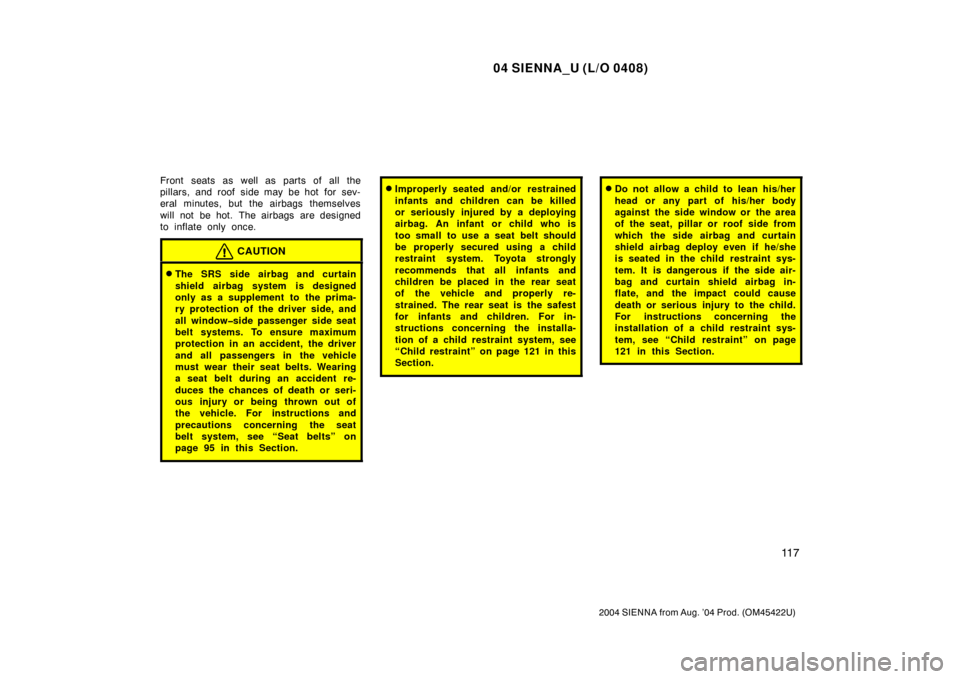
04 SIENNA_U (L/O 0408)
11 7
2004 SIENNA from Aug. ’04 Prod. (OM45422U)
Front seats as well as parts of all the
pillars, and roof side may be hot for sev-
eral minutes, but the airbags themselves
will not be hot. The airbags are designed
to inflate only once.
CAUTION
�The SRS side airbag and curtain
shield airbag system is designed
only as a supplement to the prima-
ry protection of the driver side, and
all window�side passenger side seat
belt systems. To ensure maximum
protection in an accident, the driver
and all passengers in the vehicle
must wear their seat belts. Wearing
a seat belt during an accident re-
duces the chances of death or seri-
ous injury or being thrown out of
the vehicle. For instructions and
precautions concerning the seat
belt system, see “Seat belts” on
page 95 in this Section.
�Improperly seated and/or restrained
infants and children can be killed
or seriously injured by a deploying
airbag. An infant or child who is
too small to use a seat belt should
be properly secured using a child
restraint system. Toyota strongly
recommends that all infants and
children be placed in the rear seat
of the vehicle and properly re-
strained. The rear seat is the safest
for infants and children. For in-
structions concerning the installa-
tion of a child restraint system, see
“Child restraint” on page 121 in this
Section.�Do not allow a child to lean his/her
head or any part of his/her body
against the side window or the area
of the seat, pillar or roof side from
which the side airbag and curtain
shield airbag deploy even if he/she
is seated in the child restraint sys-
tem. It is dangerous if the side air-
bag and curtain shield airbag in-
flate, and the impact could cause
death or serious injury to the child.
For instructions concerning the
installation of a child restraint sys-
tem, see “Child restraint” on page
121 in this Section.
Page 127 of 506
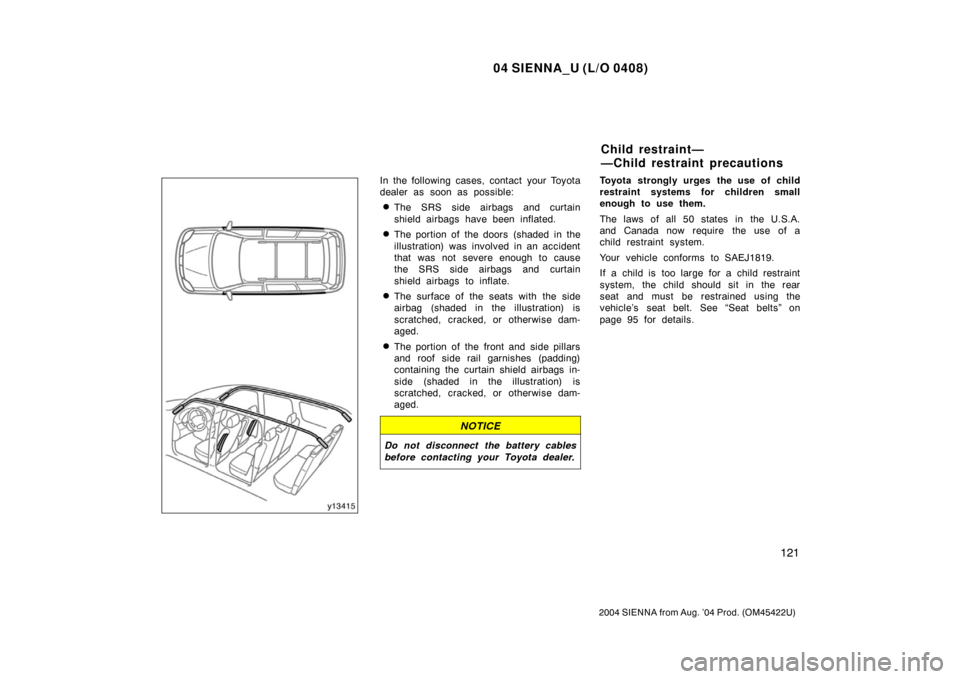
04 SIENNA_U (L/O 0408)
121
2004 SIENNA from Aug. ’04 Prod. (OM45422U)
In the following cases, contact your Toyota
dealer as soon as possible:
�The SRS side airbags and curtain
shield airbags have been inflated.
�The portion of the doors (shaded in the
illustration) was involved in an accident
that was not severe enough to cause
the SRS side airbags and curtain
shield airbags to inflate.
�The surface of the seats with the side
airbag (shaded in the illustration) is
scratched, cracked, or otherwise dam-
aged.
�The portion of the front and side pillars
and roof side rail garnishes (padding)
containing the curtain shield airbags in-
side (shaded in the illustration) is
scratched, cracked, or otherwise dam-
aged.
NOTICE
Do not disconnect the battery cables
before contacting your Toyota dealer.
Toyota strongly urges the use of child
restraint systems for children small
enough to use them.
The laws of all 50 states in the U.S.A.
and Canada now require the use of a
child restraint system.
Your vehicle conforms to SAEJ1819.
If a child is too large for a child restraint
system, the child should sit in the rear
seat and must be restrained using the
vehicle’s seat belt. See “Seat belts” on
page 95 for details.
Child restraint—
—Child restraint precautions
Page 128 of 506
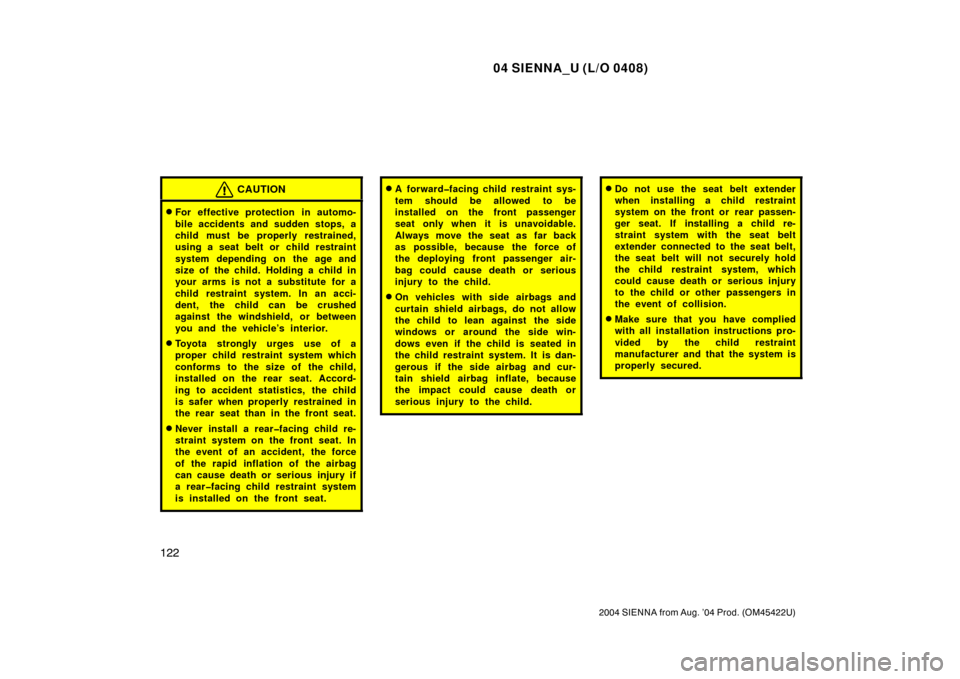
04 SIENNA_U (L/O 0408)
122
2004 SIENNA from Aug. ’04 Prod. (OM45422U)
CAUTION
�For effective protection in automo-
bile accidents and sudden stops, a
child must be properly restrained,
using a seat belt or child restraint
system depending on the age and
size of the child. Holding a child in
your arms is not a substitute for a
child restraint system. In an acci-
dent, the child can be crushed
against the windshield, or between
you and the vehicle’s interior.
�Toyota strongly urges use of a
proper child restraint system which
conforms to the size of the child,
installed on the rear seat. Accord-
ing to accident statistics, the child
is safer when properly restrained in
the rear seat than in the front seat.
�Never install a rear�facing child re-
straint system on the front seat. In
the event of an accident, the force
of the rapid inflation of the airbag
can cause death or serious injury if
a rear�facing child restraint system
is installed on the front seat.
�A forward�facing child restraint sys-
tem should be allowed to be
installed on the front passenger
seat only when it is unavoidable.
Always move the seat as far back
as possible, because the force of
the deploying front passenger air-
bag could cause death or serious
injury to the child.
�On vehicles with side airbags and
curtain shield airbags, do not allow
the child to lean against the side
windows or around the side win-
dows even if the child is seated in
the child restraint system. It is dan-
gerous if the side airbag and cur-
tain shield airbag inflate, because
the impact could cause death or
serious injury to the child.
�Do not use the seat belt extender
when installing a child restraint
system on the front or rear passen-
ger seat. If installing a child re-
straint system with the seat belt
extender connected to the seat belt,
the seat belt will not securely hold
the child restraint system, which
could cause death or serious injury
to the child or other passengers in
the event of collision.
�Make sure that you have complied
with all installation instructions pro-
vided by the child restraint
manufacturer and that the system is
properly secured.
Page 129 of 506
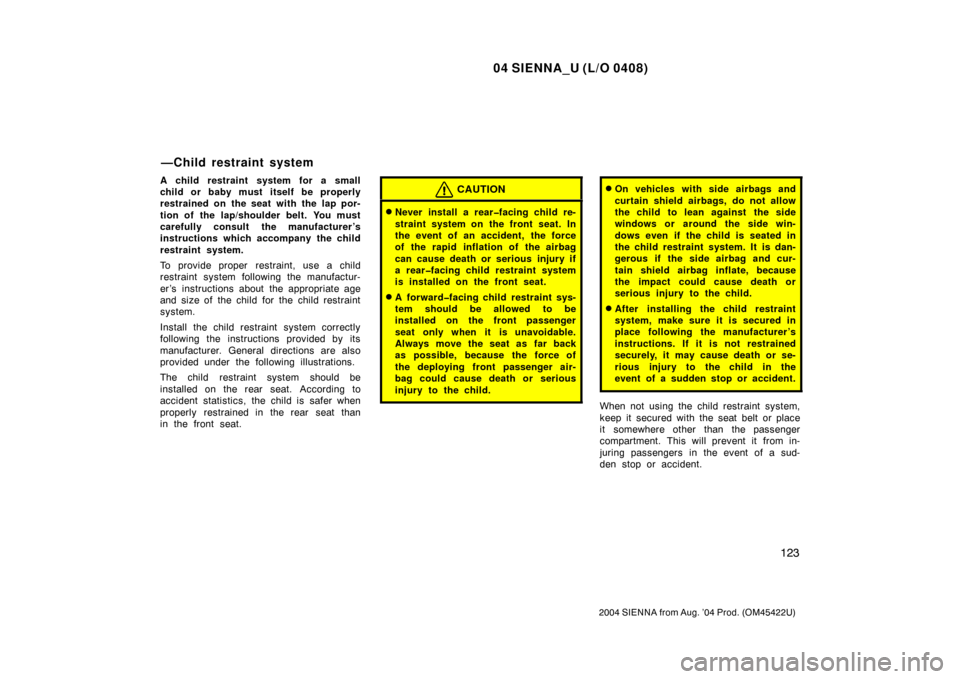
04 SIENNA_U (L/O 0408)
123
2004 SIENNA from Aug. ’04 Prod. (OM45422U)
A child restraint system for a small
child or baby must itself be properly
restrained on the seat with the lap por-
tion of the lap/shoulder belt. You must
carefully consult the manufacturer ’s
instructions which accompany the child
restraint system.
To provide proper restraint, use a child
restraint system following the manufactur-
er ’s instructions about the appropriate age
and size of the child for the child restraint
system.
Install the child restraint system correctly
following the instructions provided by its
manufacturer. General directions are also
provided under the following illustrations.
The child restraint system should be
installed on the rear seat. According to
accident statistics, the child is safer when
properly restrained in the rear seat than
in the front seat.CAUTION
�Never install a rear�facing child re-
straint system on the front seat. In
the event of an accident, the force
of the rapid inflation of the airbag
can cause death or serious injury if
a rear�facing child restraint system
is installed on the front seat.
�A forward�facing child restraint sys-
tem should be allowed to be
installed on the front passenger
seat only when it is unavoidable.
Always move the seat as far back
as possible, because the force of
the deploying front passenger air-
bag could cause death or serious
injury to the child.
�On vehicles with side airbags and
curtain shield airbags, do not allow
the child to lean against the side
windows or around the side win-
dows even if the child is seated in
the child restraint system. It is dan-
gerous if the side airbag and cur-
tain shield airbag inflate, because
the impact could cause death or
serious injury to the child.
�After installing the child restraint
system, make sure it is secured in
place following the manufacturer ’s
instructions. If it is not restrained
securely, it may cause death or se-
rious injury to the child in the
event of a sudden stop or accident.
When not using the child restraint system,
keep it secured with the seat belt or place
it somewhere other than the passenger
compartment. This will prevent it from in-
juring passengers in the event of a sud-
den stop or accident.
—Child restraint system
Page 130 of 506
04 SIENNA_U (L/O 0408)
124
2004 SIENNA from Aug. ’04 Prod. (OM45422U)
Child restraint systems are classified into
the following 3 types depending on the
child’s age and size.
(A) Infant seat
(B) Convertible seat
(C) Booster seat
Install the child restraint system following
the instructions provided by its manufac-
turer.
Your vehicle has anchor brackets for se-
curing the top strap of a child restraint
system.
For instructions about how to use the an-
chor bracket, see “—Using a top strap” on
page 135 in this Section.
The child restraint lower anchorages ap-
proved for your vehicle may also be used.
See “—Installation with child restraint low-
er anchorages” on page 138 in this Sec-
tion.
(A) Infant seat
(B) Convertible seat
(C) Booster seat
—Types of child restraint
system
Page 131 of 506
04 SIENNA_U (L/O 0408)
125
2004 SIENNA from Aug. ’04 Prod. (OM45422U)
(A) INFANT SEAT INSTALLATION
An infant seat is used in rear�facing
position only.CAUTION
�Never install a rear�facing child re-
straint system on the front passen-
ger seat because the force of the
rapid inflation of the front passen-
ger airbag can cause death or seri-
ous injury to the child.
�Do not install a child restraint sys-
tem on the second (or third) seat if
it interferes with the lock mecha-
nism of the front (or second) seats.
This can cause death or serious in-
jury to the child and passengers
sitting in front (or second) seats in
case of a sudden braking or a colli-
sion.
�If the driver ’s seat position does
not allow sufficient space for safe
installation, install the child re-
straint system on the second right
seat.
—Installation with seat belt
Page 132 of 506
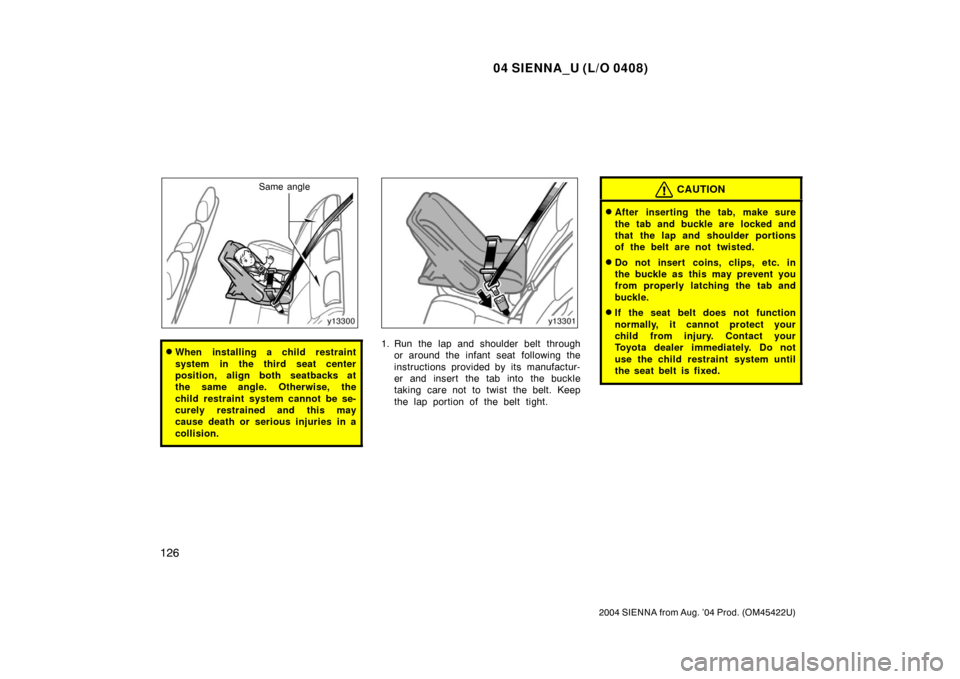
04 SIENNA_U (L/O 0408)
126
2004 SIENNA from Aug. ’04 Prod. (OM45422U)
Same angle
�When installing a child restraint
system in the third seat center
position, align both seatbacks at
the same angle. Otherwise, the
child restraint system cannot be se-
curely restrained and this may
cause death or serious injuries in a
collision.1. Run the lap and shoulder belt throughor around the infant seat following the
instructions provided by its manufactur-
er and insert the tab into the buckle
taking care not to twist the belt. Keep
the lap portion of the belt tight.
CAUTION
�After inserting the tab, make sure
the tab and buckle are locked and
that the lap and shoulder portions
of the belt are not twisted.
�Do not insert coins, clips, etc. in
the buckle as this may prevent you
from properly latching the tab and
buckle.
�If the seat belt does not function
normally, it cannot protect your
child from injury. Contact your
Toyota dealer immediately. Do not
use the child restraint system until
the seat belt is fixed.
Page 133 of 506
04 SIENNA_U (L/O 0408)
127
2004 SIENNA from Aug. ’04 Prod. (OM45422U)
2. Fully extend the shoulder belt to put itin the lock mode. When the belt is
then retracted even slightly, it cannot
be extended.
To hold the infant seat securely, make
sure the belt is in the lock mode before
letting the belt retract.3. While pressing the infant seat firmly against the seat cushion and seatback,
let the shoulder belt retract as far as
it will go to hold the infant seat secure-
ly.CAUTION
Push and pull the child restraint sys-
tem in different directions to be sure
it is secure. Follow all the installation
instructions provided by its manufac-
turer.